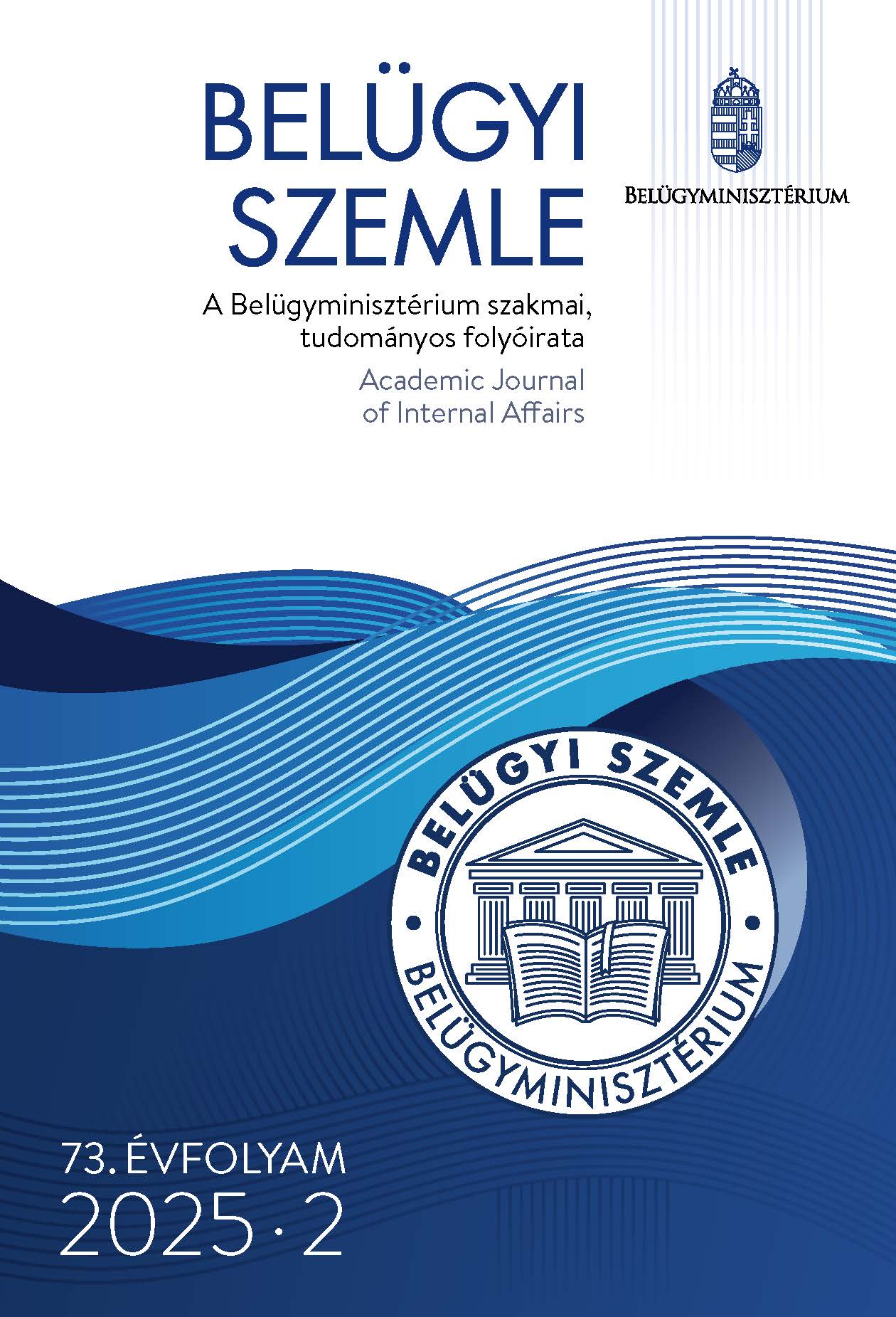Abstract
Aim: Crimes committed on railways and trains are at the center of the study with the question of how different built environmental and geographical factors affect them, what it depends on where, with what frequency and what type of crime they commit.
Methodology: The data included in the research were taken from the databases of MÁV-START Zrt. and the National Police Headquarters (crime location: railway), which were examined according to the following factors: types of crime; location, settlement; railway line, railway station; train; period; and the effect of crime prevention tools. The research is based on the theories of environmental criminology, geography of crime and situational crime prevention.
Findings: During the 5 years under review the number of crimes committed on trains has increased. Of the factors examined the location of the railway lines has the greatest impact on criminals. Most crimes are committed in Budapest and in the north-western region of Hungary, Győr, especially on railway line 1. Different types of crimes are committed on the western and eastern railway lines. In terms of types of trains, most crimes are committed on Railjet trains and passenger trains. These are mainly committed in February and the summer. Crime prevention tools and techniques used on trains are becoming more and more common. The examined factors not only affect the offenders individually, but also collectively.
Value: I have drawn conclusions about the connection with crimes committed on railways and social, socio-economic factors in Hungary. I also emphasize the importance of crime prevention techniques that can help to improve passenger safety and the reduce crime in rail transport.
References
Borbíró A. (2019). Bűnmegelőzés. In Borbíró A., Gönczöl K., Kerezsi K. & Lévay M. (Szerk.), Kriminológia (2. kiadás). Wolters Kluwer Hungary Kft. https://doi.org/10.55413/9789632959313
Clarke, R. V. (1983). Situational crime prevention? It’s theoretical basis and practical scope. Crime and Justice, 4, 225–256. https://www.journals.uchicago.edu/doi/abs/10.1086/449090
Csiszár Cs. (2006). A biztonság fokozása telematikai rendszerekkel a közforgalmú közlekedésben. Közlekedéstudományi Szemle, 56(1), 7–17.
Irk F. (2008). Szituációs bűnmegelőzés lakóövezetekben. In Barabás T., Dallos E., Irk F., Kovács R. & Windt Sz. (Szerk.), Épített környezet – bűnözés – szituációs bűnmegelőzés. A lakótelepi bűnmegelőzés alapkérdései (pp. 78–106). Országos Kriminológiai Intézet.
Kara L. (2017). Bűnmegelőzés építészeti eszközökkel. Lechner Nonprofit Kft.
Központi Statisztikai Hivatal. (2020). Magyar statisztikai évkönyv, 2019. Xerox Magyarország Kft. https://www.ksh.hu/docs/hun/xftp/idoszaki/evkonyv/evkonyv_2019.pdf
Mátyás Sz. (2017). A bűnelemzés kartográfiai lehetőségei – avagy a bűnözési térképek alkalmazása a mindennapi rendőri munka során. Pro Publico Bono – Magyar Közigazgatás, (2), 158–175.
Mátyás Sz. (2020). Bűnözésföldrajz. Egyetemi jegyzet. Didakt Kiadó.
Mátyás Sz., Bói L., Frigyer L., & Nyitrai E. (2019). Településszerkezet és kriminalitás. Nemzetbiztonsági Szemle, 7(1), 42–51. https://doi.org/10.32561/nsz.2019.1.4
MÁV-START Kommunikáció. (2020). Testkamerával biztonságosan. Vasutas Magazin, 70(8), 34–35. https://www.mavcsoport.hu/sites/default/files/upload/page/vm275x210mm_okt_magazin.pdf
MÁV-START Zrt. (2010). A MÁV-START a vasúti személyszállító zártkörűen működő részvénytársaság személyszállítási üzletszabályzata. A vasúti személyszállítási szerződés általános feltételei (pp. 12–14). MÁV-START Zrt. https://www.mavcsoport.hu/mav-start/dokumentumok/uj-szemelyszallitasi-uzletszabalyzat-es-az-uzletpolitikai-kedvezmenyek
Molnár I. (2020). A bűnmegelőzési stratégia. In Barabás A. T. (Szerk.), Alkalmazott kriminológia (pp. 305–318). Dialóg Campus.
Nagy T. (2019). A bűnügyi statisztika. In Borbíró A., Gönczöl K., Kerezsi K. & Lévay M. (Szerk.), Kriminológia (2. kiadás) (pp. 313–350). Wolters Kluwer Hungary Kft.
Nagy T. (2021). Tájékoztató a bűnözés 2020. évi adatairól. Legfőbb Ügyészség. http://ugyeszseg.hu/wp-content/uploads/2022/01/tajekoztato-a-bunozes-2020.-evi-adatairol.pdf
Patkós Cs. & Tóth A. (2012). A bűnözés néhány térbeli jellemzője a rendszerváltás utáni Magyarországon. Területi Statisztika, 52(3). https://www.ksh.hu/terstatkereso#/year/2012?c=t#03
Podoletz L. (2019). Környezeti kriminológia. In Borbíró A., Gönczöl K., Kerezsi K. & Lévay M. (Szerk.), Kriminológia (2. kiadás) (pp. 233–251). Wolters Kluwer Hungary Kft. https://doi.org/10.55413/9789632959313
Vajda A. (2017). Vasúti személyszállítás 2. Infojegyzet, 82(1–4). https://www.parlament.hu/documents/10181/1202209/Infojegyzet_2017_82_vasuti_szemelyszallitas_2.pdf/c3fcd84a-d620-4153-916d-e87ea4b134c5

This work is licensed under a Creative Commons Attribution-NonCommercial-NoDerivatives 4.0 International License.
Copyright (c) 2025 Academic Journal of Internal Affairs
